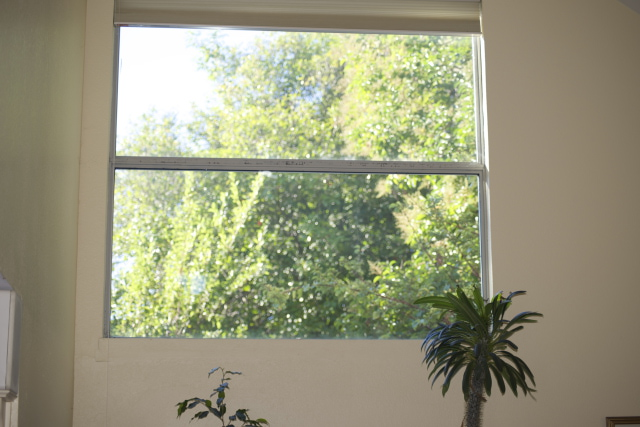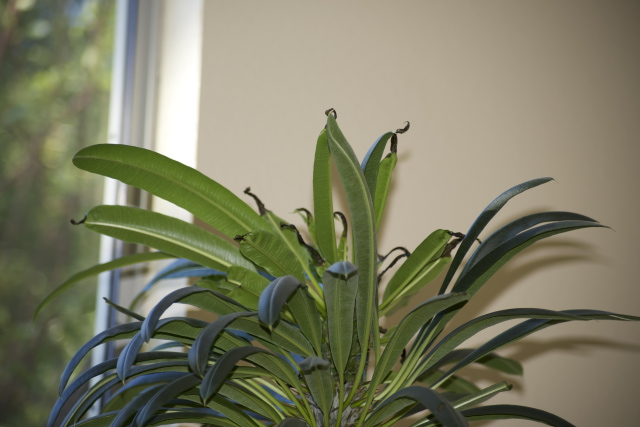Question Madagascar 2
Madagascar 2
 Madagascar 1
Madagascar 1
QUESTION: Hello,
I have a Madagascar Palm that has been a house plan for 30 years. It is now taller than me.
I had it in my sunroom addition for 10 years where it thrived since the roof was glass. A few months ago I had to move it to my living room because it became too tall for my sunroom.
One month ago I noticed black edges to new growth. Which crinkle and get sap on the end. It had been in the same pot for 15 years so I decided to repot it to a large pot. I thought it could also been lack of water since my daughter neglected her watering duties for a couple of weeks.
The black edges continue with the repotting. Not sure if I am under watering or overwatering. I had to give it significant water during repotting; but let it dry out for three weeks before recently watering it again.
Perhaps it could be the light. I have raised the plant up so that it gets southern sun for part of the day. This is the only window in the house that has a high enough ceiling to accommodate the plant.
Perhaps raising the plant higher in the window may help with the light situation.
Not sure what the problem is but would appreciate your expert advise on helping my dear 30 year old plant.
Kind regards and thank you,
Mike
ANSWER: Hi Mike,
Your plant is suffering from too little light and too much water. Madagascar Palms come from sunny, dry locations so they do not tolerate reduced light or soil that retains moisture for long.
When you moved your plant to lower light, you also should have reduced the watering frequency because plants use less water in lower light. In addition, re-potting is the exact opposite of what you should have done. In repotting, you added more soil (that also may not have been sufficiently porous) that retains water for a longer time and keeps the soil in the root zone from drying out deep into the pot within a week or two. Consequently, the roots are rotting.
You should carefully undo the repotting by gently removing all soil that you added around, under and on top of the rootball. Try to keep the original soil rootball intact. Then, move the slimmed down rootball back into its original pot or one that is smaller. Do not water your plant until the soil is very dry about halfway deep into he pot. That should occur within 7-14 days. If it takes longer than that, then add less water each time you water.
Improve the light as much as you can by placing the plant directly in front of your sunniest available window that is completely uncovered throughout the day. Raise it up so that the foliage is as high as the window.
I have written a detailed article on repotting that I will email for free to you (or anyone else) who emails a request to me at
[email protected]. I have also written an indoor plant care book in a PDF format that I can sell you if you contact me at my email address.
Please let me know if any of this is unclear or if you have any additional questions.
If this information has been helpful, please click the Rate Volunteer bar below and enter a rating and NOMINATION for me. I am a volunteer on this site so Ratings are the only compensation I receive for answering plant questions.
Need more information? Visit my website at:
A link to HorticulturalHelp.com
or email me at
[email protected] or call me at 917-887-8601 (EST)
Regards,
Will Creed, Interior Landscaper
Horticultural Help, NYC
Visit my website at: A link to HorticulturalHelp.com
---------- FOLLOW-UP ----------
QUESTION: Thank you so much.
I have ordered a higher plant stand which should help with some of the light problem.
Would it be adequate to raise the pot up and stop watering the plant versus re-potting? Re-potting this plant is quite the task since it is so high and has so many long needles.
If so, how long before I water it again? Once per month? Every two weeks.
Thanks again.
Mike
ANSWER: Hi Mike,
The soil around the roots must dry out quite thoroughly every 7-10 days. If it takes longer than that to dry, then root rot will set in. That is why over-potting so often leads to root rot.
If you don't want to downsize the pot, you should remove all soil you added to the top of the surface of the rootball. Then, water only when the soil is dry halfway down into the soil. You will have to determine just how much water to add so that it dries out to the level again within 7-10 days.
~Will
---------- FOLLOW-UP ----------
QUESTION: Will, another follow-up question. I now have the plant on a very high stand so that the leaves are all in the window.
Why is only the new leaves turning black at the tips? The existing leaves look fine.
I live in the San Francisco Bay area and winter is approaching. Although it is an indoor plant, light will be further reduced, so I am assuming less water.
When I do water, do I water just the root ball and avoid the sides? How much water should I give it at each watering? A cup? 2 cups?
Thanks again. Sorry for so many questions. The plant is 30 years old and I don't want to lose it.
AnswerHi Mike,
Root rot usually affects new growth more than old growth leaves. The leaves already affected will not recover, so you should trim off the dry tips so you can monitor any future damage. If the roots are not too badly damaged and you get the soil moisture under control, then there should be little further deterioration.
Don't make assumptions about your plants water requirements or depend on precise watering schedules or water quantities. As I mentioned previously, allow the soil to dry halfway down into the rootball and then add just enough water so that it reaches that level of dryness again in 7-10 days. You will have to experiment to determine just what the right quantity is. Apply the water slowly all around the soil surface. You do not need to water they plant stem, although that does no harm. The over sized pot makes all of this more difficult.
~Will







